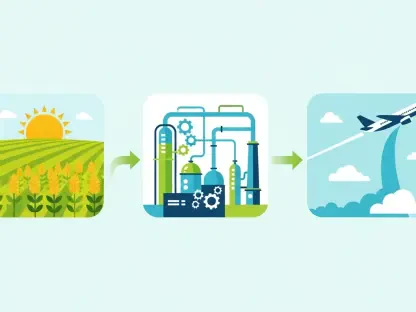In the rapidly evolving sphere of energy economics, Christopher Hailstone stands out as a leading figure with a wealth of knowledge in energy management, renewable energy, and electricity delivery. His keen insights, especially when it comes to grid reliability and security, make him a sought-after expert on pressing industry topics. Today, we explore Russia’s coal industry challenges, delving into sanctions’ impacts, strategic partnerships, and government interventions aimed at sustaining this critical sector.
Can you elaborate on the specific reasons why Russia’s coal exports have dropped recently?
Russia’s coal exports have experienced a decline primarily due to a combination of Western sanctions and internal challenges. Sanctions have restricted Russian access to traditional markets, particularly in Europe and the U.S., forcing a pivot to Asian markets. Additionally, infrastructure disruptions, coupled with falling global coal prices and a stronger rouble, have stressed the industry’s profitability, contributing to an overall decrease in exports.
How have Western sanctions specifically impacted the Russian coal industry?
The sanctions have severely limited Russia’s ability to sell coal to the West, prompting logistical hurdles. They have made it challenging to transport coal to distant Asian markets cost-effectively. The sanctions have also reduced the industry’s financial stability, applying pressure on enterprises and causing significant revenue losses due to restricted market access and increased costs.
What support measures has President Putin ordered the government to develop for the coal industry?
President Putin has directed the government to develop a comprehensive support plan that includes rail transportation discounts, guaranteed export routes, and potential subsidies for Russian Railways. These measures aim to alleviate some of the financial and operational pressures facing the coal sector while ensuring continued production and employment.
How do the proposed rail transportation discounts aim to support the coal industry?
The discounts on rail transportation fees are intended to reduce logistics costs, thereby making Russian coal more competitive in global markets. By decreasing costs associated with long-distance transportation, these discounts help improve profit margins for coal producers, which is crucial amid declining global prices and increased financial stress.
What are the specific regions in Russia that will benefit from the proposed rail transportation discounts?
Primarily, the Kuznetsk Basin (Kuzbass) and neighboring regions like Khakassia will benefit from these discounts. These are key coal-producing areas in Russia, and the targeted discounts will aid in sustaining their operations and ensuring these regions continue to contribute significantly to Russia’s coal output.
How are current issues like falling global coal prices and logistics costs affecting Russian coal producers?
The combination of falling global coal prices and high logistics costs is squeezing the margins of Russian coal producers. Lower prices mean less revenue per unit sold, while high transportation costs eat into these already reduced earnings, challenging the financial viability of many enterprises within the sector.
Could you explain the financial challenges the coal industry faces, as described by Deputy Prime Minister Alexander Novak?
Deputy Prime Minister Novak highlighted the sector’s significant financial losses, amounting to billions in roubles over the past year. Factors such as sanctions, currency fluctuations, and import duties in key markets like China and India have exacerbated these challenges, leading to the risk of bankruptcy for many producers and affecting thousands of workers.
What are the risks of bankruptcy within the coal sector, and how many workers could be affected?
The coal sector is at risk of widespread bankruptcy, threatening about 30 enterprises that employ around 15,000 workers. These challenges stem from persistent financial losses coupled with market and operational constraints, putting jobs and regional economies in peril.
How does the recent agreement to guarantee exports from the Kuznetsk Basin aim to support the industry?
The agreement to guarantee exports from the Kuznetsk Basin is designed to secure a stable revenue stream for producers in this vital region. By ensuring a consistent export flow, the agreement helps mitigate some market uncertainties and provides a foundation for longer-term planning and investment in the coal industry.
What potential benefits or challenges might arise from negotiating to abolish import duties on Russian coal with China and India?
Negotiating to abolish import duties could significantly enhance Russia’s coal market competitiveness in China and India. The potential benefits include expanded market access and improved profit margins. However, the challenges may involve complex diplomatic negotiations and the need to address potential geopolitical tensions as part of these discussions.
Can you discuss the proposal for subsidies for Russian Railways and how this might impact the company?
Proposing subsidies for Russian Railways aims to counteract revenue losses due to reduced cargo volumes. This support could stabilize the company’s financial performance, allowing it to maintain essential services and infrastructure investments, even when dealing with decreased profitability from lower transportation fees.
What role is the VEB state development bank expected to play in restructuring and rehabilitating coal producers?
The VEB state development bank is slated to offer financial mechanisms, such as tax and insurance deferrals, potentially introduce special bankruptcy procedures, and provide much-needed liquidity for struggling producers. These measures aim to sustain the coal sector’s operations, preserving jobs and regional economies.
Could you explain the significance of Russian Railways’ cargo volumes falling to their lowest in 15 years?
The drop in cargo volumes indicates the broader economic challenges facing the coal sector, reflecting decreased domestic and international demand. It also highlights Russian Railways’ financial constraints, necessitating strategic adjustments through reduced investment and potential subsidies to maintain its operations.
How does the reduction in investment by Russian Railways relate to its financial performance amid rising interest rates?
Investment cutbacks are a direct response to reduced revenue and an effort to ensure fiscal stability amid rising interest payments. As the central bank raises rates to curb inflation, the increased borrowing costs for Russian Railways create a challenging environment for substantial capital outlays, leading to a re-evaluation of spending priorities.
How does Moscow view its strategic partnership with China and India in the context of U.S. trade policies?
Moscow views strengthening ties with China and India as crucial for counterbalancing the effects of U.S. trade policies, especially amid ongoing sanctions. By negotiating improved trade agreements and reducing tariffs, Russia aims to secure these partnerships as buffers against Western economic pressures.
Could you detail the types of “special bankruptcy procedure” that might be introduced for struggling coal producers?
The proposed “special bankruptcy procedure” would likely provide a structured process to manage financial distress, potentially including debt restructuring, asset sale facilitation, and creditor negotiations. Such a framework aims to ensure continuity of operations while minimizing disruptions to employment and economic stability in coal-dependent regions.
In what ways might the proposed “specialized tool” by the VEB bank help support coal producers?
The “specialized tool” could offer tailored financial solutions like liquidity support, investment in technological upgrades, and advisory services for operational improvements. These efforts are expected to bolster the coal industry’s resilience and adaptability amidst ongoing economic challenges.
Do you have any advice for our readers?
In the current global economic climate, diversification and innovation in energy sources are crucial. Staying informed about international trade dynamics and technological advancements can help individuals and companies better prepare for the future shifts in the energy landscape.









